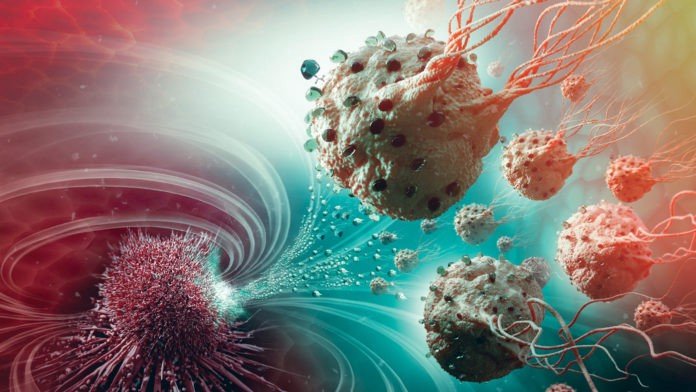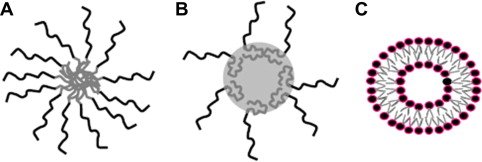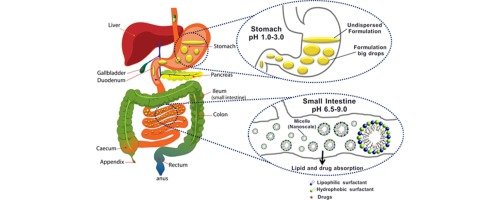Recently, nanotechnology drug delivery systems have been widely used in various fields such as food industry, biosensors, catalysts and gene transfer. Nanoparticles are particles with a size ranging from 1 to 100 nanometers and may exhibit extraordinary properties and functions at certain size ranges, unlike their volumetric constructions. The main reasons for the superior properties of nanoparticles are quantum size effects, size dependence of electronic structure, unique characteristics of surface atoms and high surface/volume ratio.

Drug-loaded nanoparticles can beneficially enhance their therapeutic efficacy by enhancing the bioavailability of the drug. Controlled release preparations based on nanoparticles provide a higher penetration of the drug into the cellular construct, resulting in the slow and controlled release of the drug to the target site.
The development of nanotechnology and biotechnology has the potential to be applied in drug delivery systems, resulting in the development of new drug formulations, accelerating the adoption of conventional drugs for new drug products.
The main objectives of the development of nano-biotechnological drug release systems are following;
- Specific drug targeting and release
- While reduction of toxicity, treatment effects are maintained
- High reliability and biocompatibility
- Rapid development of new safe drugs
There are many types of drug delivery systems developed for targeted and controlled release. Smart drug delivery systems are the main group of these systems where the drug release rate can be adjusted.
Smart Drug Delivery Systems
Smart drug delivery systems are divided into two groups as open loop control systems and closed circuit control systems. While open loop control systems provide drug release in the presence of magnetic, thermal, ultrasonic, and electrical stimuli, drug delivery systems that respond to pH in the closed circuit type, molecular targeting such as urea-sensitive drug release systems, glucose-sensitive insulin release systems the rate of release is checked without any external intervention.
What Is The Smart System?
A smart system is one that can change its characteristics in response to environmental changes. Each cell type can produce responses at different levels in the biological system. For example, the cells of the immune system migrate to specific locations in the body, depending on the particular chemical concentration known as cytokines. Similarly, the amount of glucose in the blood is adjusted to the amount of insulin produced by beta cells in the Langerhans islets. An ideal drug delivery system should be multifunctional, but here are the most important requirements of the intelligent system;
- Improve drug solubility and stability
- Dosing frequency as well as dosage reduction
- Reduce/eliminate side effects
- Development of non-toxic carrier system for biological system
- Non-triggering of negative immune reactions
- Transmission of the drug at the required amount over a long period of time
The important point in smart drug delivery systems is that when the drug is transported to the desired location, the drug is released in the required amount during binding to the relevant cells. At this point, a stimulant is needed to control the drug release. These stimuli may be external stimuli such as electric field, magnetic field, ultrasound, electromagnetic radiation, as well as internal stimuli such as pH, temperature, ionic medium, carbohydrates, and proteins. In this case, smart drug delivery systems provide programmable and controllable drug release.
Depending on the functional area employed, it appears that "Smart Drug Delivery Systems" have certain advantages such as low systemic toxicity and side effects and increased therapeutic efficacy compared to conventional drug delivery systems. Conventional drugs have a predetermined rate of drug and drug release, independent of any internal or external stimuli. On the other hand, smart drug systems are working with the release strategy on demand. The most known example of smart systems is self-regulating insulin release systems in response to environmental effects caused by changes in the glucose level.
Lipid, polymer and inorganic based structures are used to develop nano delivery systems. Today, the most studied and developed nano-delivery systems are polymeric conjugates, polymeric micelles, polymeric nanoparticles, dendrimers, polymerzomes, liposomes, carbon nanotubes and gold nanoparticles.
Smart Drug Delivery Systems
Polymeric Micelles
Polymeric micelles are nanoscopic (> 100 nm) amphiphilic block copolymers with core shell structure. The unique properties of polymeric grains, such as nanometer range size, relatively high stability due to their low critical concentration, and core shell regulation, are used in clinical applications in drug delivery systems, particularly in very low resolution drug delivery systems in hydrophobic water.
Polymeric Nanoparticles
They demonstrate a structure that shares the structure of the core shell structure of biodegradable hydrophobic polymers protected by an amphiphilic block copolymer that stabilizes their dispersion in an aqueous environment. These are matrix-type, solid-colloidal particles, and therefore usually exhibit greater stability than miscellaneous. They are usually larger than polymeric micelles and may show some size distribution.
Liposomes
Micro and nano colloidal drug delivery systems have been used for many years, such as emulsions, suspensions and liposomes. Recently, nano-sized liposomal systems smaller than 100 nm have been used as model cells or carriers for a variety of bioactive agents including vaccines, cosmetics and nutraceuticals. These cells can sometimes be coated with polymers such as polyethylene glycol. This form usually extends the half-life in the bloodstream. Nano-structured liposome delivery systems work very effectively in reducing systemic toxicity and preventing premature drug degradation in the capsule.

Polymeric micelles and nanoparticles have been extensively investigated for drug release. Polymeric micelles can be regarded as unique systems in which the assembled amphiphilic copolymers are in free dynamic balance.
Various factors, including parameters such as the physicochemical properties of the drug and the core forming polymer, loading method and hydrophobic block length, as well as the nature of the solvent used in the loading process, are influenced by the loading of the drugs into the polymeric micelles and nanoparticles. Factors such as the chemical composition of the core-forming polymer, polymer drug compatibility and also the physical state of the micelle material can significantly change the drug loading and affect the release kinetics.
pH-Sensitive Nano Gel Systems
pH sensitive nano gels are protonated or tend to deprotonate based on pH. This changes the interaction forces between the individual polymer chains in the gel and indicates the gel swelling behavior. Chitosan, poly (L-lysine), poly (vinyl pyridine), poly (2-diisopropylaminoethyl methacrylate) gels, poly (acrylic acid), poly (methacrylic acid) and alginate gels exhibit maximum swelling at alkaline pH. In their loaded state, neighbor polymer chains are subjected to repulsive forces. To compensate for this repulsive force, the counter ions coming from the medium enter the gel matrix, and through the water molecules that come with them, the gel is swollen and the drug is released. This phenomenon has been used to provide controlled release, especially in the treatment of gastrointestinal system disorders.

The pH-sensitive nano-gel smart delivery drug structure that is summarized is a copolymer system consisting of N, N 'dimethyl acrylamide and t-butyl acrylamide. Drug-loaded nanoparticles pass through different pH regions until they reach the gastrointestinal by oral route. For example, proton-loaded acrylic acid coated nanoparticles in the acidic gastric environment (pH: 1-3) exhibit minimal swelling. As the environment becomes alkaline in the gut, negative carboxylate groups tend to counteract the gel and the gel is inflated so that drug release can be achieved at the desired level in the desired gastrointestinal tract.

Electronically Controlled Nanoplates
Scientists have studied electronically controlled drugs to reduce potential side effects in targeted drug delivery systems. Researchers have also tried to load anticancer drugs on nano-graphene oxide plates with drug-specific properties. However, graphene oxide nanoparticles are incorporated into the electrically conductive polymer thin film and loaded with an antiinflammatory drug. When the material is exposed to electric current, it is observed that the drug is released as a continuous reaction.
Scientists are also investigating how much drug can be loaded by conducting experiments on gross surface oxide plate sizes and thicknesses. Studies in this area also include the experiments on the release of drugs waiting in the body at the onset of seizures in the treatment of epilepsy.
The Future of Nanotechnology Applications
It might be said that nanotechnology applications in the coming years will have a wide variety of uses and potentially save a large number of lives. Today, while targeted drug treatment methods or smart drugs, which are often subject to scientific research, are promising, it is seen that nanotechnology will also help to form molecular systems that can be striking to living systems. These molecular structures may now form the basis for the renewal or renewal of lost body parts for infection, accident or disease. Incorporating these strategies into the skeleton through tissue engineering techniques can open up future work.
In today's technology, design and test new methods of controlling the interaction of nanomaterials with the body, and to target these technologies to specific areas of the body without being caught by organs such as the liver and spleen when converted into treatments are important difficulties.
As can be understood from all these developments, the increase in clinical studies in the near future is expected to be much wider in the diagnosis and treatment of the diseases most frequently encountered, and it is anticipated that more smart drugs will be offered instead of traditional medicines with the development of the existing technological infrastructure.
References:
- Sezer,A.D,2016, Smart Drug Delivery System
- Cui,X.T. 2014, Electronically controlled drugs could minimize side effects, ACS News Service Weekly
- Nanoparticles Smart Drug Delivery System for Cancer, October-13, LexInnova
- https://www.ncbi.nlm.nih.gov/pmc/articles/PMC4924501/
- http://www.nanotechproject.org/inventories/medicine/
- https://en.wikipedia.org/wiki/Targeted_drug_delivery
Being A SteemStem Member
this is a very technical stuff...but. this is a good one..
Nicely written.
Technology can only get better. Maybe nanotechnology (or rather nanobots, as the case maybe) could be what we will use to win the war against some form of diseases; cancer for example.
Well, let's all keep an open mind
Aren't side effects more related to the drug itself and not the mode of delivery? I mean, mode of delivery is a factor too, but isn't drug structure also an important factor?
Nanotechnology has a lot of potential, especially with regards to medicine. Not only with drug delivery, it can also be applied for other uses, say surgeries?
this is technical news